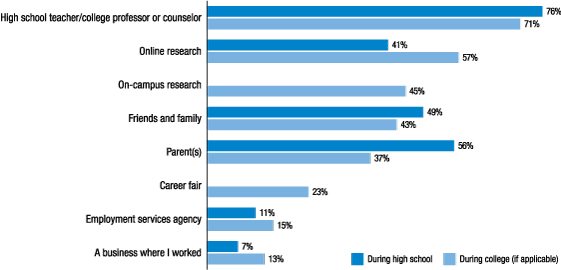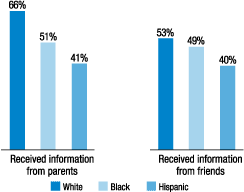Experiences and Perspectives of Young Workers
Connecting Education and the Labor Market
Whether an individual attends college and completes his or her degree has long been understood to be a major determinant of lifetime income and financial well-being. Because choosing a postsecondary program is a substantial investment decision facing many young adults, accurate information about the risks and rewards associated with educational options is in high demand.
Information about Jobs and Careers
The survey asks respondents whether they learned about jobs and careers during high school or during college.28 In the 2015 survey, 66 percent of respondents received information about jobs and careers during high school, representing a slight increase over the 63 percent who received this information in 2013. Likewise, there was a small increase from 2013 (66 percent) to 2015 (69 percent) in the percent of respondents who received information about jobs and careers during college (figure 11).
In 2015, among those who received information about jobs and careers during high school, most received the information from their teachers or counselors (76 percent). Also notable, 56 percent received information from their parents, 49 percent received information from other family (not parents) and friends, and 41 percent found the information through online research (figure 12).

In 2015, the sources of information about jobs and careers during college were similar to those reported during high school. Among those who received information during college, most received the information from their college professors or counselors (71 percent). Furthermore, 57 percent received the information from online research, 45 percent received information through on-campus recruitment, 43 percent received information from friends and family, and 37 percent said they received information from their parents (figure 12).
Aligning Education and Work
The survey probes respondents about whether their paid job is aligned with their educational studies. The survey shows that 45 percent of employees with postsecondary education are employed in a career field that is closely related to their education and training. The employees most likely to be working in their field of study have postsecondary education and training in engineering (70 percent), education (67 percent), vocational or technical fields, (65 percent), computer/information sciences (64 percent), and health (53 percent). Please note, the sample sizes are very small for some fields of study (table 20).
| Program | Employees working in a career field that is closely related to education and training (respondents with postsecondary education) (percent) |
Number of responses |
|---|---|---|
| Engineering | 70 | 84 |
| Education | 67 | 68 |
| Vocational/technical training | 65 | 54 |
| Computer/information sciences | 64 | 68 |
| Life sciences | 58 | 39 |
| Physical sciences/math | 56 | 38 |
| Business/management | 54 | 156 |
| Health | 53 | 143 |
| Social/behavioral Sciences | 51 | 88 |
| Law | 49 | 42 |
| Humanities | 38 | 52 |
Note: Small sample sizes.
Early Work Experience
In order to examine the relationship between early work experience and labor market outcomes, the survey asked respondents about their work experience during high school and college, if applicable. In the survey, 53 percent of respondents held a paid job while they were in high school. For respondents with postsecondary education, 77 percent had a paid job while they were enrolled in college. Further examination of correlation between early work experience and labor market outcomes are discussed further in the Profile of Employees section.
Many respondents also gained early work experience through internships. Among respondents with postsecondary education, 15 percent held a paid internship, 14 percent held an unpaid internship, and 3 percent held both a paid and an unpaid internship. Most respondents who held internships (89 percent) found the experience to be worthwhile.29 More specifically, 26 percent said their internship led to a paid job, 58 percent said the internship improved their skills, and 6 percent said the internship led to other benefits.
Job Searches
At every level of educational attainment, the most frequently used strategy for job searches was to contact the employer directly. However, those with a bachelor's degree or a high school education or less were far more likely to employ this strategy (61 percent and 64 percent, respectively) than those with a certificate or technical degree (44 percent)
(figure 13).
Figure 13. When you last searched for a job, please indicate whether you used each of the following strategies during the whole process

After contacting an employer, employees were next most likely to search electronic boards (e.g., Monster, CareerBuilder) and post an online resume (e.g., LinkedIn, Twitter). Again the intensity was quite different between employees with a bachelor's degree (53 percent), a certificate or technical degree (42 percent), and high school or less education (29 percent) (figure 13).
The survey asks respondents with a paid job how they searched for their current job. Analysis of the employee responses shows that search strategies differ by level of educational attainment. First, employees with a bachelor's degree conduct a more intense search (average of 2.68 strategies per respondent) than employees with either a high school education or less or employees with a certificate or technical degree (average of 2.15 and 2.16 strategies per respondent, respectively) (table 21).
| Response | Educational attainment | ||
|---|---|---|---|
| High school or less | Certificate or technical degree | Bachelor's degree | |
| Average number of strategies employed in job search | 2.15 | 2.16 | 2.68 |
| Number of responses | 383 | 56 | 322 |
Note: Small sample size for respondents with certificate or technical degree.
Box 3. White Respondents Have More Early Work Experience than Black or Hispanic Respondents
In the survey, 62 percent of white respondents worked while in high school compared with 50 percent of black respondents and 39 percent of Hispanic respondents. Similarly, 79 percent of white respondents worked while in college compared with 64 percent of black respondents and 70 percent of Hispanic respondents. Findings were similar for the 2013 Survey of Young Workers.
Related Research on Connecting Education and the Labor Market
Like workers with postsecondary education, individuals with early work experience have been more successful in the labor market. Notably, in a 2014 study by the Brookings Institution, teenage employment is associated with improved employment and earnings outcomes later in life.30
Despite the important role of early job experience in job readiness, employment opportunities for high school students have been declining in recent years, particularly among African American youth. The Organisation for Economic Co-operation and Development found that in 2007, 19 percent of low-income African American teenagers worked compared with nearly 50 percent of affluent white teenagers.31 Because teen and young adult unemployment is concentrated among less-educated and low-income individuals, this phenomenon threatens the upward mobility of already vulnerable populations.32
Furthermore, the system of school education for youth followed by on-the-job learning in the workplace has been replaced by an expectation of lifelong learning and "credentialing" to upgrade skills and adapt to occupational structures. Because the phases of education and work are no longer linear, it is critical that workers are able to navigate the relationships between educational programs and the labor market.33
Research indicates that social capital and other intangible factors play a role in the uneven labor market outcomes between racial and ethnic groups. A study by the Urban Institute found that while it is unclear whether racially prejudiced employers, insufficient job networks, or limited work experience cause the labor market differences, it is clear that black youth (16- to 24-year-olds) are not obtaining full-time, steady work.34
Box 4. White Respondents Are More Likely to Receive Job Information from Friends and Family than Black and Hispanic Respondents
During high school, white respondents were more likely to receive information about jobs and careers from their parents (66 percent) and friends (53 percent) than black respondents (51 percent and 49 percent, respectively) and Hispanic respondents (41 percent and 40 percent, respectively) (figure B).

References
28. In the survey, respondents with postsecondary education (including those who have not completed a certificate or degree) were asked about their "college" experience. Return to text
29. In the survey, 551 respondents held an internship during college. Return to text
30. Andrew Sum, Ishwar Khatiwada, Mykhaylo Trubskyy, and Martha Ross with Walter McHugh and Sheila Palma, The Plummeting Labor Market Fortunes of Teens and Young Adults (Washington: The Brookings Institution, March 2014), www.brookings.edu/wp-content/uploads/2014/03/Youth_Workforce_Report_FINAL-1.pdf ![]() . Return to text
. Return to text
31. Kuczera and Field, A Skills beyond School Review. Return to text
32. Sum, Khatiwada, Trubskyy, and Ross, The Plummeting Labor Market Fortunes. Return to text
33. Anthony P. Carnevale, Andrew R. Hanson, and Artem Gulish, Failure to Launch: Structural Shift and the New Lost Generation(Washington: Georgetown University, 2013), https://cew.georgetown.edu/wp-content/uploads/2014/11/FTL_FullReport.pdf ![]() . Return to text
. Return to text
34. Margaret Simms and Marla McDaniel, The Black-White Jobless Gap, Urban Institute brief (Washington: Urban Institute, September 2010), www.urban.org/research/publication/black-white-jobless-gap ![]() . Return to text
. Return to text

